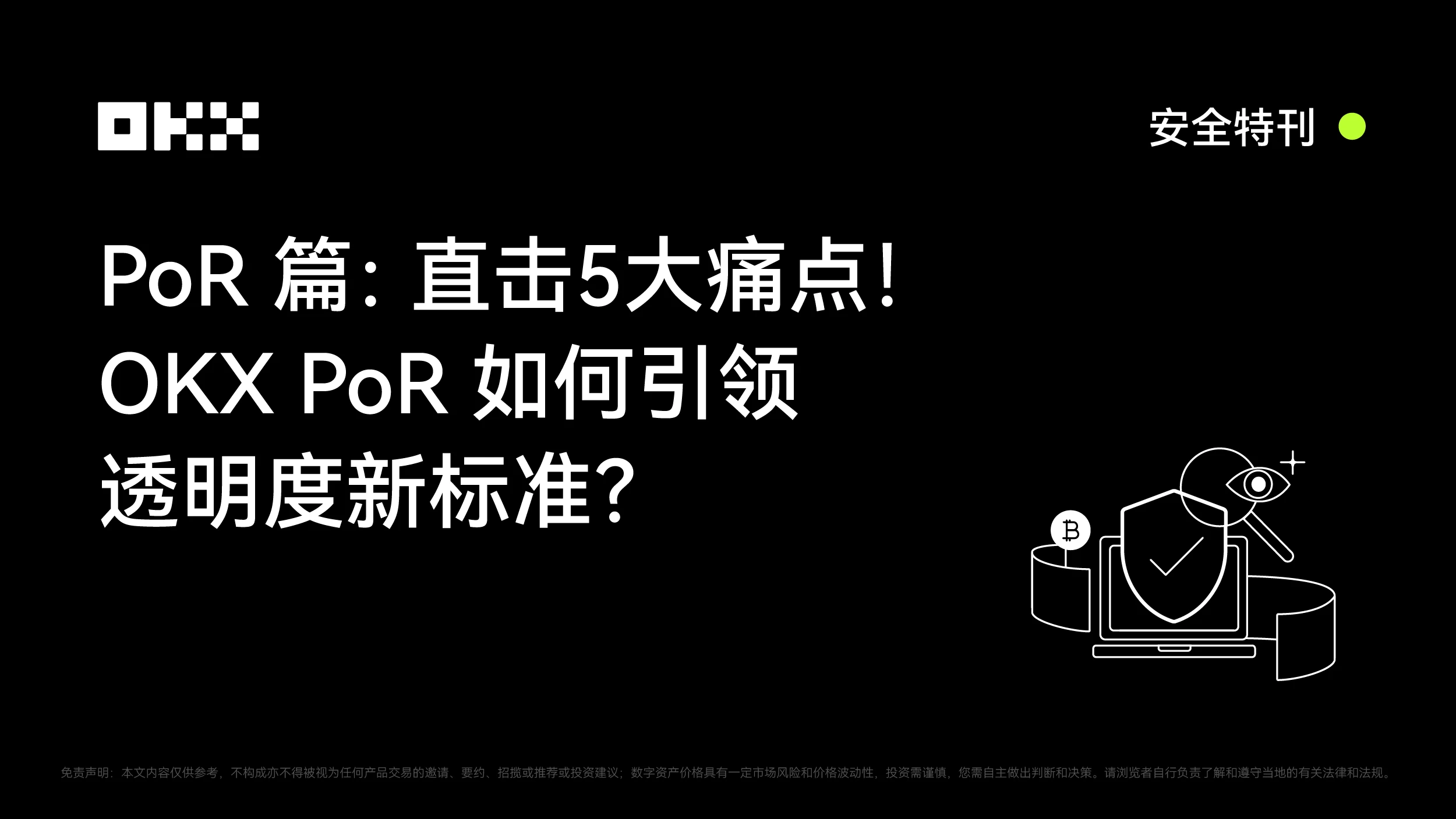
At least 11 mainstream centralized exchanges around the world have released PoR (Proof of Reserves) reports, which aim to prove solvency by comparing platform reserves with user assets. This is a proactive self-regulatory behavior of centralized exchanges in the absence of unified supervision.
PoR has improved the information asymmetry between platforms and users to a certain extent, and has gradually become the default self-regulatory paradigm in the crypto industry. However, the implementation levels of various exchanges vary: most are still at a single point in time for verification, with conflicts between privacy and transparency, doubts about the authenticity of liabilities, and difficulty in assessing asset quality. To address these pain points, OKX has built a more credible verification system by introducing zero-knowledge proofs, open source verification tools, expanding currency coverage, and increasing reporting frequency. This article will deeply analyze the core pain points of the current PoR mechanism and explore how OKX can promote industry transparency upgrades through technology and process optimization.
Pain point 1: Limitations of time point verification
PoR is usually based on a snapshot of assets and liabilities at a certain point in time, which makes it difficult to reflect the real financial dynamics of the exchange. When the market fluctuates violently or funds flow frequently, this static information can hardly help users judge the immediate solvency of the exchange, which can easily lead to a crisis of trust. For example, the collapse of FTX in 2022 exposed this problem: users suffered heavy losses due to the inability to obtain real-time data. In addition, some exchanges may even temporarily borrow assets before the audit and transfer them out immediately after the audit to create the illusion of sufficient assets. Although on-chain tracking is improving identification capabilities, this short-term behavior still seriously undermines the credibility of PoR. More importantly, many exchanges lack a stable publishing mechanism, and even interrupt report updates when asset conditions are tight, further exacerbating the trust gap.
In contrast, OKX insists on publishing PoR reports on a monthly basis, with more than 30 issues in total, setting an industry benchmark in terms of frequency and consistency. By continuously disclosing the status of platform assets, OKX avoids the formalism of one-time releases or low-frequency disclosures, allowing users to dynamically observe financial trends instead of relying on one-time snapshots. This long-term, stable and transparent mechanism significantly enhances the actual value of PoR and provides a more reference verification path for exchange trust building.
Pain point 2: Verification vulnerabilities of data authenticity and integrity
Although the PoR mechanism can prove that the exchange holds sufficient assets, that is, platform assets ≥ user deposits (platform liabilities), it cannot guarantee the authenticity and completeness of these data themselves. For example, under normal circumstances, the deposit balance of each user should be positive:
Reality:
User deposits (platform liabilities): Xiao A deposits 10,000 yuan, Xiao B deposits 20,000 yuan
Platform actual assets: 20,000
PoR: 20,000 (platform assets) ÷ 30,000 (platform liabilities) ≈ 67% (insolvency)
Counterfeiting operation:
In order to fake a 100% reserve rate, a bad exchange may create a negative account, for example, claiming that Xiao C owes the exchange 10,000
User deposits (platform liabilities) were tampered with to: 30,000 (platform liabilities) - 10,000 (fictitious platform liabilities) = 20,000 (artificially reducing liabilities);
Fake PoR: 20,000 (platform assets) ÷ 20,000 (platform liabilities after tampering) = 100% (seemingly safe).
How does OKX intercept negative value accounts and other forms of data fraud through technical constraints? OKX uses zk-STARK technology to prove and verify all OKX account assets held by the exchange. OKX will take a snapshot of all user accounts and constrain them according to the zk-STARK algorithm. The first is the balance sum constraint, which requires that the total amount of assets is equal to the sum of the account asset balances; the second is the non-negative constraint, which does not allow the inclusion of negative asset accounts to inflate the book value; the third is the inclusive constraint, which requires that no account is left out, thereby ensuring the authenticity and integrity of the PoR data.
It is worth noting that compared to other PoR technologies, the zk-STARK technology does not require any trusted setup to generate mathematically verifiable proofs, and anyone can independently verify its correctness. The entire process does not rely on secret information or external trust and is completely decentralized, avoiding platform black box operations and setting loopholes. It is the most secure solution for PoR at present.
Pain point 3: Technical threshold for user verification
Although PoR theoretically allows users to verify by themselves, in practice, ordinary users often lack the necessary technical knowledge to independently verify the exchanges reserve proof, resulting in most users still having to passively trust the conclusions of exchanges or third-party auditing agencies. This technical threshold severely limits the actual utility of PoR.
OKXs zk-STARK PoR solution supports user self-verification, truly realizing the core concept of Dont Trust, Verify. For example, users can verify the inclusive constraint by following the steps below:
Log in to your OKX account to view the PoR report details
Get JSON data containing account balance and Merkle path
Use open source tools to independently verify whether your account assets are included in the Merkle node
Users can also verify the balance sum constraint and non-negative constraint, as well as OKXs ownership of the wallet address and wallet assets, through the self-verification tutorials and tools provided by OKX. https://www.okx.com/zh-hans/proof-of-reserves. In more detail, OKX PoR also uses recursive proof technology to compress all the data used for verification into a small file of less than 1 MB. In other words, users do not need to download proof files of hundreds of MB or even GB, which greatly improves the efficiency and transparency of self-verification.
Pain point 4: No PoR audit standards
Currently, there is no unified PoR standard and method in the industry. Faced with the various verification processes and report formats of various exchanges, users find it difficult to compare the security of various platforms horizontally, and it is impossible to evaluate the professionalism and credibility of the audit results. This lack of standardization increases the cognitive burden of users and provides room for bad exchanges to manipulate data. This further weakens the transparency and user trust of the entire industry.
In response to this pain point, OKX has launched a double layer of protection: internal self-certification and external verification. On the one hand, the innovative zk-STARK zero-knowledge proof technology eliminates potential loopholes in traditional reserve proofs, achieves efficient verification without the need for third-party trust, and brings reserve transparency to a new level; on the other hand, it cooperates deeply with the independent third-party auditing agency Hacken to conduct regular monthly audits, disclose the audit process and on-chain data, and allow users to review and independently verify at any time. On this basis, OKX will also open source the entire PoR system, with detailed documentation and verification tools, to provide the industry with a replicable standardized technical template, which will not only facilitate instant verification and supervision by developers and the security community, but also help promote industry consensus and PoR standardization.
Pain point 5: Insufficient asset quality assessment
When many exchanges release PoR reports, they often only stay at the level of how much money and what currencies there are, lacking in-depth analysis of asset quality, which is mainly reflected in: the coverage of currencies is relatively small, usually only mainstream or platform currencies are listed, ignoring the unpopular currencies and high-risk assets that account for a large proportion of holdings; the proportion of platform currencies is too high, and the overall valuation is easily pushed up after the introduction of their own tokens, and there is a risk of false high valuation driven by interests; the superficial market value display, even if unpopular tokens are announced, is only presented in book quantity or market value snapshots, without comprehensive evaluation combined with market depth, liquidity or price fluctuations. These deficiencies make it difficult for users to accurately judge the real solvency of the exchange. Once the market declines rapidly or liquidity drops sharply, the gap between book assets and actual liquidity will expose security risks, giving users a false sense of security and facing uncontrollable potential risks. The gap between book assets and actual solvency will expose security risks, giving users a false sense of security and potential uncontrollable risks.
OKX displays asset quality in multiple dimensions, rather than focusing only on quantity:
The cleanliness of non-platform coins is about 70%, and the reserve rate for the PoR of each mainstream currency is maintained at more than 100%, proving that even without relying on platform coins, user liabilities can be fully covered.
In the latest PoR, the total value of the four major currencies, BTC, ETH, USDT, and USDC, accounted for about 66%. The total value of the top 10 mainstream currencies accounted for about 88.8%, and the total value of the 22 public currencies accounted for about 90%, reflecting a healthier asset structure and risk diversification.
Recently, the reserves of mainstream currencies have changed steadily upward, such as ETH increased by 13.7% and BTC increased by 5.6%, indicating that users and institutions have continued to increase their confidence in the platforms security and liquidity management.
At the same time, OKX continues to expand the range of currencies covered by its PoR, from the initial 3 currencies to the current 22 currencies, basically covering the main holdings of users, achieving a double improvement in the asset coverage and depth of the PoR report, and providing users with a more comprehensive and transparent solvency reference.
Leading the new standard of PoR transparency
OKXs fully upgraded PoR not only represents a technological leap, but also demonstrates the social responsibility of the company. For users, transparency is no longer an option, but an obligation of the exchange; asset verification is no longer a privilege, but a basic right of every user. This upgrade has achieved a qualitative change from passive trust to active verification for users. For the industry, this move brings the crypto world back to its original intention of centralization, marking the beginning of the maturity of crypto finance and setting a new transparency and security benchmark for the entire industry.
For OKX itself, the PoR system design makes any evil mathematically impossible, and the exchange does not need to build credibility through word of mouth; when transparency is deeply rooted in the protocol level, regulators can also rest assured; when prevention mechanisms become the norm in the industry, black swan risks are greatly reduced. Looking back at the development of crypto assets, every trust crisis has spawned new solutions, and this time, OKXs PoR is not only a technological breakthrough, but also a liberation of ideas - proving to the world: in the Web3 world, trust can be encoded, transparency can be verified, and security can be witnessed.
Disclaimer
This article is for reference only. This article only represents the authors views and does not represent the position of OKX. This article is not intended to provide (i) investment advice or investment recommendations; (ii) an offer or solicitation to buy, sell or hold digital assets; (iii) financial, accounting, legal or tax advice. We do not guarantee the accuracy, completeness or usefulness of such information. Holding digital assets (including stablecoins and NFTs) involves high risks and may fluctuate significantly. You should carefully consider whether trading or holding digital assets is suitable for you based on your financial situation. Please consult your legal/tax/investment professionals for your specific situation. Please be responsible for understanding and complying with local applicable laws and regulations.










